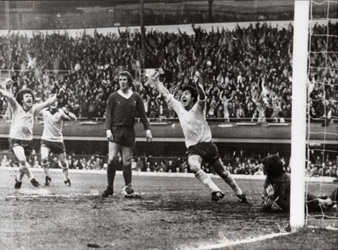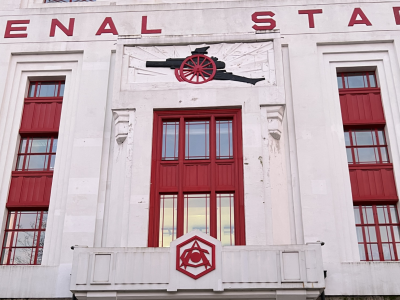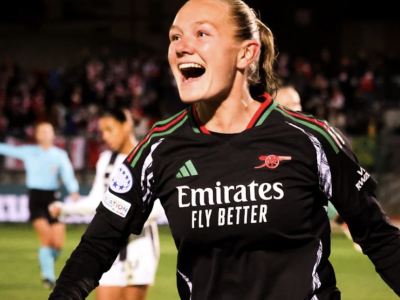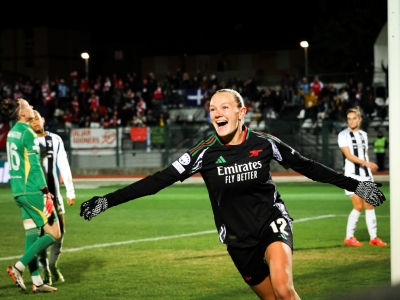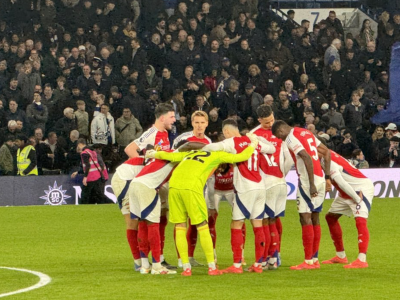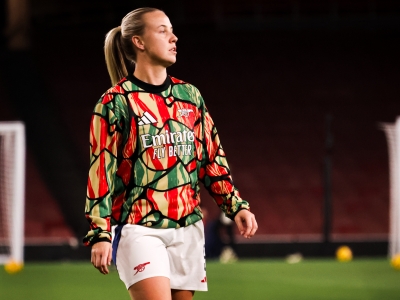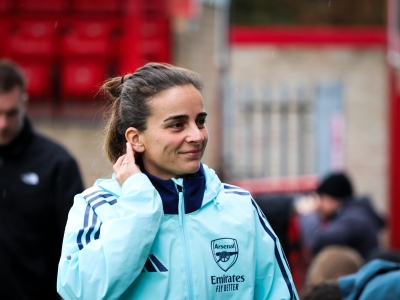Arsenal’s very first FA Cup Semi Final came on the last day of March 1906 at Stoke City’s Victoria Ground against Newcastle United. At the time, the Gunners were known as Woolwich Arsenal and at the time were languishing in sixteenth place in the old First Division, having never previously won a major trophy. The Magpie’s in contrast sat in ninth place. The Gunners dreams were dashed by a 0-2 defeat, with Newcastle progressing to meet Everton in the final at Crystal Palace after the Toffees beat Liverpool in an all-Merseyside Semi Final. Everton ended up winning the Cup with a 1-0 win courtesy of goal from future Spurs player Sandy Young.
Not down hearted, the Gunners came back the following year to face Sheffield Wednesday (then simply known as The Wednesday) at St. Andrews in Birmingham in late March 1907. Woolwich Arsenal were seventh in the first division table, while Wednesday languished in twelfth place. Wednesday inflicted a 1-3 defeat on Woolwich Arsenal to add another disappointment. This time Wednesday went on to win the trophy, beating Cup holders Everton 2-1 at Crystal Palace. The Gunners had to wait another twenty years before the next FA Cup Semi Final appearance, this time against Southampton at Stamford Bridge in late March 1927.
By this point, Arsenal had been resident in North London for fourteen years and Herbert Chapman installed as boss for the last two years. At the time, Arsenal were thirteenth in the old First Division, while Southampton were eighth in the second tier. On this occasion, the Gunners triumphed with a 2-1 win, with goals from Joe Hulme and Charlie Buchan. Arsenal however went on to lose the final to Cardiff City. Arsenal were back a year later to face Blackburn Rovers at Leicester City’s Filbert Street. Arsenal at the time stood in tenth place in the top flight, while Blackburn Rovers were also in the old First Division, in sixth place. Arsenal suffered a 0-1 defeat, Rovers then went on to take the Cup that year after defeating Huddersfield Town in the final.
It took the Gunners another two years before they progressed to the Semi Final stage again. This time Arsenal faced Hull City at Elland Road in Leeds. At the time, Arsenal stood in sixteenth place and only four points from the relegation zone, while Hull City were nineteenth in the second tier, themselves only three points off the drop zone to the old Third Division North. A shock was on the cards as the Gunners were two goals down at half time, the second an Eddie Hapgood own goal. Goals for David Jack and Cliff Bastin pulled Arsenal back on level terms, with the game ending in a 2-2 draw.
The replay took place at Villa Park four days later. Early on, Hull City defender Arthur Childs was sent off for kicking out at an Arsenal player. One newspaper report claimed that: ‘Hull City’s vigorous tackling lowered the standard of play, and there was much indiscriminate kicking’. One Hull local newspaper however claimed that their home team were hard done by in that: ‘for the remainder of the game, the official in charge got no peace from a crowd that obviously resented his action. I have never heard such continuous booing before on a football ground’. A goal for David Jack gave Arsenal a 1-0 victory and a final appearance against Herbert Chapman’s old side Huddersfield Town, which the Gunners won 2-0 to win their first FA Cup and their first ever major trophy after forty four years in existence. Hull in contrast ended 1929/30 relegated to the third tier.
Arsenal were back in the Semi Finals two years on to face Man City at Villa Park. The Gunners were third in the top flight, three points behind leaders Everton with hopes of becoming the first side during the twentieth century to win the ‘elusive’ League and FA Cup Double. Man City on the other hand stood in twelfth place. A goal for Cliff Bastin gave Arsenal a 1-0 win. The Gunners however finished the season trophy-less, but runners up in both the League and FA Cup. Arsenal’s last Semi Final of the Pre-War era came in late March 1936 at Leeds Road in Huddersfield. The opposition were Grimsby Town, who were two points above the relegation zone in the top flight in nineteenth place. Arsenal on the other hand – after a hat-trick of League titles - were sixth in the table, but fourteen points off of leaders Sunderland.
A Cliff Bastin goal in front of a crowd of 63,210 meant a 1-0 win for Arsenal, to put them through to the Final at Wembley against Sheffield United, which the Gunners won 1-0. Five years after the end of the Second World War, Arsenal were back in the FA Cup Semi Final against Chelsea at White Hart Lane. Arsenal stood sixth, while Chelsea were twelfth in the old First Division. The Gunners fell two goals behind in the first half, with Roy Bentley twice on target for the Pensioners. In the Second half, former Spurs player Freddie Cox took a corner and scored direct for Arsenal on his former home ground. From a Leslie Compton corner, his brother Dennis headed for Arsenal’s equaliser, earning Arsenal a 2-2 draw.
The replay took place four days later again at White Hart Lane. A goal for Freddie Cox meant that Arsenal were through to their first post-war FA Cup Final, against a Liverpool side who defeated Everton 2-0 at Man City’s Maine Road home. Two Reg Lewis goals earned Arsenal their third FA Cup win. Two years later, the Gunners would play Chelsea again at White Hart Lane. The Gunners were once again in the running for the elusive Double. Arsenal were only kept off the top of the table by Matt Busby’s Man United by goal average. Chelsea in contrast were seventeenth place in the top tier.
The first tie had been abandoned due to snow. The tie finally took place a week later in front of a crowd of 68,084. The game ended in a 1-1 draw with Freddie Cox on target for Arsenal again. The replay took place forty eight hours later, again at White Hart Lane. Goals for Doug Lishman and two for Freddie Cox meant a 3-0 victory for Arsenal. The Gunners progressed to Wembley, but again the Double was missed with a third place finish in the League and losing 0-1 to Newcastle United in the FA Cup Final at Wembley.
There would be a nineteen year gap between that Semi Final and the next one at the end of March 1971 against Stoke City at Hillsborough. Arsenal were second in the table at the time, while Stoke City were twelfth. The Gunners fell two goals behind by half time, with Dennis Smith and John Ritchie on target. Two goals for Peter Storey however pulled Arsenal level – the second a penalty in the very last minute of the game against the world’s number one goalkeeper, Gordon Banks, to earn a 2-2 draw. The replay took place four days later at Villa Park in Birmingham. Goals for George Graham and Ray Kennedy meant a 2-0 victory and a trip to Wembley to face Liverpool, which secured Arsenal’s first Double in May 1971.
Twelve months on and Stoke had the opportunity to enact revenge on Arsenal, as the two sides reached the FA Cup Semi Finals again, this time at Villa Park. Arsenal were fifth in the old First Division, while Stoke were sixteenth. Stoke City had already picked up the League Cup earlier in the year and had high hopes of becoming the first side to win a Domestic Cup double. Arsenal took the lead with a shot from the edge of the area by George Armstrong. A Peter Simpson own goal however saw Stoke pull level. Arsenal played out the remainder of the game needing to protect John Radford covering in the Arsenal goal, after Bob Wilson was taken off injured. The game ended in a 1-1 draw.
Arsenal would therefore be involved in their fourth replayed Semi Final in a row. The replay took place four days later at Everton’s Goodison Park. Brian Greenhoff gave Stoke City the lead from the penalty spot. Arsenal however also equalised from the penalty spot, successfully converted by Charlie George. The tie was won by a goal from John Radford which gave Arsenal a 2-1 victory, though the final was lost 0-1 to Leeds United. The Gunners reached their third FA Cup Semi Final in a row twelve months later. Arsenal stood in second place in the League, one point behind Liverpool at the top of the table. Sunderland were thirteenth in the old Second Division.
Goals for Vic Hallom and Billy Hughes meant Sunderland inflicted a 1-2 defeat - Arsenal’s first FA Cup Semi Final defeat for forty five years - while Charlie George pulled one back for the Gunners. Arsenal therefore missed out on being the first side during the twentieth century to reach a hat-trick of finals. It was to be a feat however that Arsenal went on to achieve at the close of the 1970s. In April 1978 at Stamford Bridge, Arsenal faced the currently beleaguered Leyton Orient (though just plain Orient back then, the Leyton re-added to the club name again in 1987). Orient were nineteenth in the second tier, while Arsenal were third in the top flight. Two goals for Malcolm MacDonald (which if the dubious goals panel had existed would have both been deemed Orient own goals!) and a Graham Rix run from his own half meant a 3-0 win for the Arsenal.
Arsenal progressed to the Final in 1978 to meet Ipswich Town, however lost 0-1. Arsenal though were back twelve months on to face Wolves at Villa Park. Arsenal were fifth in the table, while Wolves were just three points above the relegation zone in nineteenth place. Goals for Frank Stapleton and Alan Sunderland against his old club meant a 2-0 win as Arsenal progressed to meet Man United in the final and pick up their fifth FA Cup win. Twelve months on, Arsenal reached the Semi Final again and with high hopes of reaching an historic third straight Wembley appearance. The only thing standing in their way were a Liverpool side four points clear at the top of the table, themselves hoping for their first League and FA Cup Double.
Arsenal themselves were in fourth place and hoping not only to retain the FA Cup, but also win the European Cup Winners Cup and drew 1-1 with Juventus in the first leg of the Cup Winners Cup Semi Final in the week prior. The first game took place at Hillsborough in mid-April. The two sides played out a 0-0 draw. The replay took place four days later at Villa Park. David Fairclough gave Liverpool the lead six minutes into the second half, before an Alan Sunderland equaliser eleven minutes later meant a 1-1 draw and the Semi Final going to a third match. Incredibly, the two sides were to meet each other in the League the following weekend, where Kenny Dalglish gave Liverpool the lead after twelve minutes, only for Brian Talbot to equalise twelve minutes from time for another 1-1 draw.
There then followed a nine day break in fixtures between the two sides. Arsenal in the meantime managed to secure their passage to the Semi Finals of the Cup Winners Cup with a 1-0 away leg win over Juventus. Three days later, on the last Saturday in April, the Gunners played out a 1-1 draw at home to Ron Atkinson’s West Brom side. Forty eight hours on, Arsenal travelled to Villa Park to resume battle with the Merseysiders. The Gunners took the lead with a goal from Alan Sunderland in just ten seconds. Arsenal also held on to the lead until the dying seconds, before a Kenny Dalglish equaliser meant a 1-1 draw and a record breaking third FA Cup Semi Final replay.
The third replay occurred three days later, on a Thursday evening at Highfield Road in Coventry. In the days before saturation coverage of football on TV, where an FA Cup Semi Final is guaranteed live TV coverage, the nation was largely settling down to watch a Top of the Pops episode hosted by Tommy Vance, where Dexys Midnight Runners topped the charts topped the charts with ‘Geno’ (the host excitingly proclaiming: ‘this is number one because it deserves to be!’). Meanwhile, over at Highfield Road after just eleven minutes a Brian Talbot header gave Arsenal the lead. This time, the Gunners hung on for a 1-0 win to take them through to a date with West Ham just nine days later.
Two days later, Arsenal played out the final Saturday of the season with a 1-0 win over Coventry – also at Highfield Road. That same day, Liverpool also played Aston Villa and secured the 1979/80 title with a 4-1 win to soften the blow of Thursday night’s defeat. Incredibly, on Bank Holiday Monday another forty eight hours on, Arsenal played their third fixture in five days, this time against European Champions Nottingham Forest. The two sides played out a 0-0 draw. In the FA Cup final, an exhausted Arsenal crashed to 0-1 defeat to West Ham, as well as losing the European Cup Winners Cup Final to Valencia on penalties, in what would pan out to be a record seventy game season for the Gunners.
What followed for Terry Neill’s Arsenal in the years ahead had a familiar ring to what currently surrounds the club today. The club never recovered from those losses, or the loss of major stars like Liam Brady and Frank Stapleton. The last hurrah for Terry Neill’s reign came in the spring of 1983, after Arsenal defeated reigning European Champions Aston Villa in the FA Cup Quarter Finals to set up a Semi Final tie with Ron Atkinson’s Man United at Villa Park. The Gunners had already been defeated by Man United in the League Cup Semi Final earlier in the season. Man United had lost the League Cup Final to Liverpool three weeks prior and were hungry for trophies having won just the one in the fifteen years since their European Cup triumph of 1968.
At the time, Man United stood third in the old First Division with two games in hand over leaders Liverpool, but twenty one points off the pace. Arsenal meanwhile languished in twelfth place. Arsenal certainly had history on their side, having won ten of their last eleven FA Cup Semi Finals that they had been involved in. Tony Woodcock gave Arsenal a first half lead, before an equaliser from Bryan Robson after the break. Seventeen year old Norman Whiteside decided the tie, after springing the Arsenal offside trap followed up with a superb strike to inflict a 1-2 defeat on the Gunners. Man United went on to win the 1983 FA Cup Final with a 4-0 win over Brighton in the replay after a 2-2 draw.

